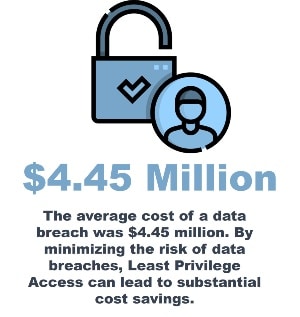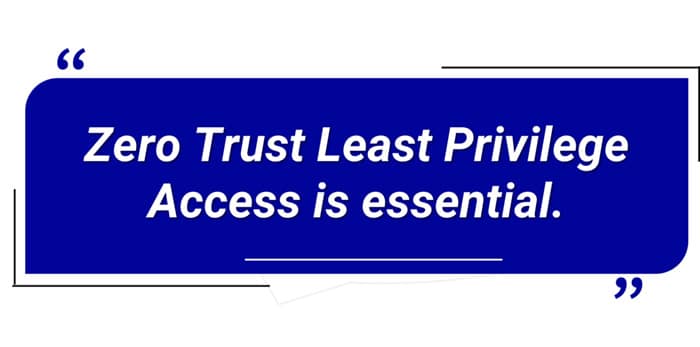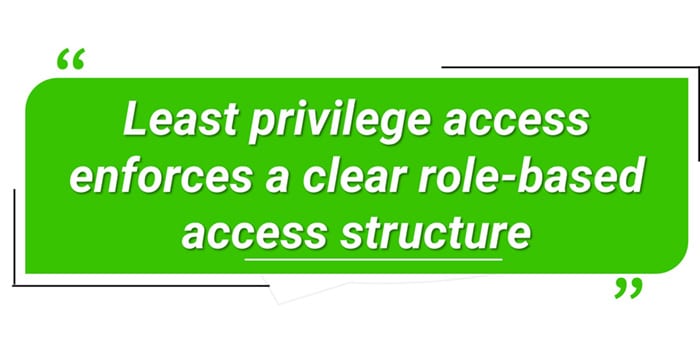
Benefits of zero trust least privilege access include reduced attack surface, enhanced compliance, and prevention of insider threats—here are 9 compelling reasons your organization needs it.
Benefits of Zero Trust Least Privilege Access: 9 Key Reasons
Estimated reading time: 3.5 minutes
Table of Contents
Introduction: How Zero Trust Least Privilege Access Reduces Risks and Protects Your Organization

At its core, Least Privilege Access is a foundational cybersecurity principle that ensures users, systems, and processes are granted only the minimum access required to perform their specific tasks. This article explores the 9 top reasons why your organization needs Zero Trust Least Privilege Access. From mitigating security risks and protecting sensitive data to improving operational efficiency and reducing the impact of ransomware, we’ll demonstrate how adopting this principle can significantly strengthen your organization’s security posture while supporting modern compliance and operational requirements.

What is Least Privilege Access?
Least Privilege Access is a fundamental cybersecurity principle that ensures users, systems, or processes are granted the minimum level of access necessary to perform their specific tasks—nothing more, nothing less. The goal is to limit access to resources, thereby reducing the attack surface and mitigating potential risks of misuse, accidental exposure, or cyberattacks. Key elements of Least Privilege Access include minimal access, role-based control, micro-segmentation and regular access rights review.
A Zero Trust Policy Server plays a central role in enforcing Least Privilege Access within a Zero Trust Architecture (ZTA). It acts as the decision-making engine that continuously evaluates and enforces access controls based on pre-defined policies, ensuring that users, devices, and applications only access what they need and nothing more.
Key Benefits of Zero Trust Least Privilege Access
-
Mitigates Security Risks
-
-
- Reduces Attack Surface: Limiting access makes it harder for attackers to exploit accounts or systems. For example, if a user account is compromised, the hacker can only access limited resources, not the entire network.
- Prevents Lateral Movement: In the event of a breach, attackers cannot move freely across systems, reducing the chance of widespread damage.
- Limits Insider Threats: Employees or malicious insiders can only access resources necessary for their role, minimizing misuse or accidental harm.
-
-
Protects Sensitive Data
-
-
- Organizations handle sensitive data like financial records, customer information, or intellectual property. Least privilege ensures access is restricted to those who truly need it. This helps prevent data leaks, unauthorized access, or accidental deletion.
-
-
Supports Regulatory Compliance
-
-
- Many industry regulations and standards require organizations to implement strict access controls and protect sensitive data. For example, GDPR requires organizations to protect and limit access to personal data. HIPAA requires healthcare data to be restricted to authorized personnel only.
-
-
Reduces Human Error
-
-
- By limiting their permissions, organizations can prevent unintended actions from employees such as accidentally deleting files or misconfiguring systems. For example, a marketing employee shouldn’t have access to server configuration settings—they could accidentally bring systems offline.
-
-
Improves Operational Efficiency
-
-
- Least privilege access enforces a clear role-based access structure, simplifying user management and reducing unnecessary permissions. It helps IT teams maintain clean, organized access control policies across systems.
-

Facilitates Zero Trust Security
-
-
- Least privilege access is a foundational principle of Zero Trust Architecture. In a Zero Trust model, users only get access to the resources they need, when they need them, and nothing more. This enhances overall security posture and aligns with modern cybersecurity frameworks.
-
-
Limits Damage from Compromised Accounts
-
-
- If an attacker gains access to a user account or system, they are limited to that user’s permissions. This containment prevents attackers from escalating privileges or accessing critical systems. For example, a compromised HR account can access employee records but not financial files or IT infrastructure.
-
-
Reduces the Impact of Malware and Ransomware
-
-
- Malware often exploits user accounts to spread or gain access to critical systems. Least privilege access restricts what the malware can access, reducing the scope and impact of the attack.
-
-
Strengthens Cloud and Hybrid Environments
-
-
- In cloud and hybrid systems, where users and devices are widely distributed, implementing least privilege prevents excessive permissions from exposing vulnerabilities.
-
| Benefit | Description |
| Reduced Attack Surface | Limits permissions to only what’s needed—nothing more |
| Prevents Insider & Lateral Threats | Blocks excessive internal access |
| Enhanced Compliance & Auditability | Enforces policies with full logs |
| Improved Incident Response | Enables rapid threat containment |
| Secure Zero Trust Data Access | Enforces file-level least privilege across environments |
Conclusion: Build Resilience Against Cyber Threats with Zero Trust Least Privilege Access
In today’s evolving threat landscape, implementing Zero Trust Least Privilege Access as implemented by FileFlex Enterprise is essential for reducing the attack surface, limiting lateral movement, and mitigating risks from cyberattacks, insider threats, and human error. Organizations can protect sensitive data, ensure regulatory compliance, and improve operational efficiency by granting users, systems, and processes only the minimum access needed to perform their tasks. Supported by a Zero Trust Architecture and robust policy enforcement, this approach strengthens security defenses across cloud, hybrid, and distributed environments, providing a resilient and proactive framework to safeguard critical assets.
To learn more about the benefits of a Zero Trust Data Access Architecture see Top 5 Reasons Why Zero Trust Micro Segmentation is Important?, Distributed Administration of Remote Unstructured Data Access for the Complex Supply Chain, Top 8 Reasons Your Organization Needs Zero Trust Activity Tracking, and Embracing Zero Trust Data Access for IT-Controlled Chain-of-Command.
*IBM
Learn More About FileFlex Sign Up for a Free TrialFrequently Asked Questions
What are the benefits of zero trust least privilege access?
Benefits include reduced attack surface, better insider threat protection, enhanced regulatory compliance, and improved incident response. It ensures users only access what they need—nothing more.
How does least privilege access support Zero Trust Security?
Least privilege access enforces Zero Trust by ensuring that access is continuously verified and restricted to minimum necessary permissions, even for authenticated users and devices.
What risks does least privilege access help mitigate?
It mitigates risks like lateral movement in a breach, insider threats, privilege escalation, and accidental data exposure by ensuring no one has more access than necessary.
How does FileFlex implement zero trust least privilege?
FileFlex applies least privilege at the file and folder level through Zero Trust Data Access, enforcing continuous authentication, granular access controls, and detailed auditing—without requiring data movement.